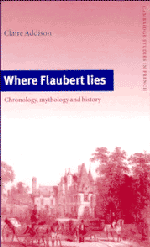Book contents
- Frontmatter
- Contents
- Publisher's note
- Acknowledgement
- Abbreviations and conventions
- Introduction
- 1 The Flaubert dates
- 2 The colours of time in the first Education sentimentale
- 3 Conception, birth, death in Madame Bovary
- 4 Heads and tails in Salammbô
- 5 Two-timing in L'Education sentimentale
- 6 The Hundred Days of Bouvard et Pécuchet
- 7 Petit dictionnaire de Flaubert
- Conclusion
- Diachronic and synchronic charts
- Bibliography
- Index
- Cambridge Studies in French
2 - The colours of time in the first Education sentimentale
Published online by Cambridge University Press: 09 October 2009
- Frontmatter
- Contents
- Publisher's note
- Acknowledgement
- Abbreviations and conventions
- Introduction
- 1 The Flaubert dates
- 2 The colours of time in the first Education sentimentale
- 3 Conception, birth, death in Madame Bovary
- 4 Heads and tails in Salammbô
- 5 Two-timing in L'Education sentimentale
- 6 The Hundred Days of Bouvard et Pécuchet
- 7 Petit dictionnaire de Flaubert
- Conclusion
- Diachronic and synchronic charts
- Bibliography
- Index
- Cambridge Studies in French
Summary
‘La belette à queue noire s'appelle hermine ou roselet; hermine lorsqu'elle est blanche, roselet lorsqu'elle est rousse ou jaunâtre … Les hermines sont … rousses en été et blanches en hiver’
Buffon: L'HermineThe first Education sentimentale begins and ends with temporal anomalies: the ‘date of completion’ affixed to the end is impossible both in terms of what is known of the historical circumstances of composition and in terms of the internal chronology of the story. In addition, many of the clues and constraints through which a chronology of the first half of the novel can be constructed are presented in a delayed position in the text, long after the events to which they refer, so that the prospective/retrospective aspect of the reader's activity is always to the fore.
Bruneau (C1, 988) claims that additions were made to ES1 between August 1846 and Louise Colet's reading of it shortly before her ‘Memento du 15 janvier 1852’ (C11, 883). The ages of Jules and Henry towards the end give 1848, and Flaubert was in the habit of bringing novels to a present-tense perspective, as the endings of Novembre, MB and ES11 show. It is most probable, therefore, that ES1 was completed towards the end of 1851 and after Flaubert began work on MB, a point signalled through the copy of Notre-Dame de Paris inscribed with the name ‘Emilie’ in ES1 (1, 340).
Why, then, does the date ‘Nuit du 7 janvier 1845, une heure du matin’ (1, 373) appear after the theatrical ending of ES1 as the final message of this polymorphous text?
- Type
- Chapter
- Information
- Where Flaubert LiesChronology, Mythology and History, pp. 22 - 47Publisher: Cambridge University PressPrint publication year: 1996



